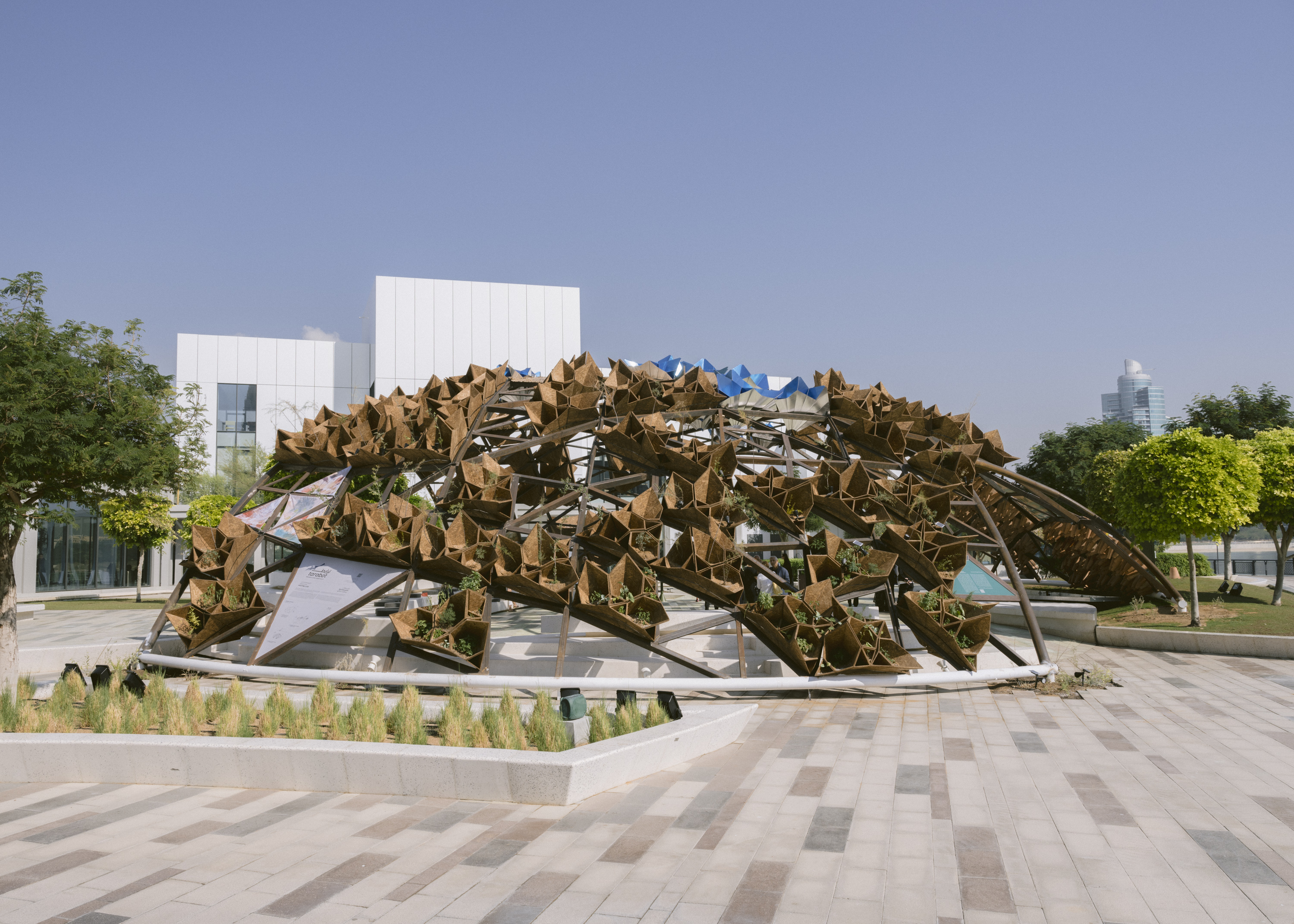
This new Art Jameel pavilion, Tarabot: Weaving a Living Forum, commissioned by the arts organisation and designed by Lebanese practice theOtherDada, is a fractal, domed structure stretching over the amphitheatre at the Jaddaf Waterfront Sculpture Park in Dubai. Weaving together traditional and high technologies, recycled waste materials and indigenous plants, the architectural pavilion aims to bring life to the area over the next five months, forming a new ‘interspecies habitat’.
It sees Art Jameel, which supports artists and creative communities and is behind both the sculpture park and the wider Jameel Arts Centre, promote a conversation about sustainability and re-use.
Founded in 2010 by architect Adib Dada, theOtherDada pushes the boundaries of traditional architecture, adopting a ‘holistic and biomimetic design approach with nature and people at its core’. Reflects Dada, ‘I had these two diametrically opposed practices – building for humans and building for other organisms […] When this commission came along, it became an opportunity to weave these two practices together in a meaningful way.’
Art Jameel pavilion, a study in sustainablity

Deeply involved in contemporary art scenes and climate activism in Beirut, from leading ‘Toxic Tours’ of the Beirut river to developing tree-planting project theOtherForest, Dada was invited to an Art Jameel symposium in March 2023 to discuss the role of arts institutions in addressing the climate crisis.
Art Jameel director Antonia Carver explains, ‘What does it mean to create exhibitions in this climate? What do we do with all the materials after?’ As a direct result of the symposium, Art Jameel has been rethinking its exhibition production processes and reusing waste such as gypsum moulds.
‘Tarabot is an Arabic word that means “weaving together” [...] we’re weaving together issues of architecture, urbanism, ecology, wildlife and human-life centred design,’ says Dada. A lack of shade and life on the pavilion’s site prompted a shade-providing design. Working closely with architect Dalia Hamati, scientists, and desert conservationists, Dada conceptualised four life-giving ‘pillars’ – Soil, Water, Plants and Energy – for the pavilion, corresponding to the dome’s three touchpoints with the ground, and its roof.

The first pillar, Soil, makes compost out of waste from the art centre’s exhibitions, neighbouring restaurant Teible and coffee shop. Encased in modular ‘bouquets’ made from local date palm waste, a zero-carbon material, by Desert Board, the waste is broken down by mycelium (the root-like system of fungus).
The Water pillar uses solar power to condense and filter water from the humidity in air. This water drips through a series of traditional passive cooling clay cones, handmade by local potters, collecting as freshwater in the pavilion pool.
The Plants pillar uses the composted soil and collected fresh water to grow vegetables that return to the restaurant. Salicornia, an indigenous edible plant able to grow in saltwater, is also planted, further attracting insects, birds and pollinators. Artwork from multidisciplinary Dubai-based artist Solimar Miller features intricate handcrafted prints on upcycled fabrics, representing indigenous flora and fauna that are endangered in the UAE.
The Energy pillar, on the roof features aluminium cones that funnel sunlight into the pavilion, and Arish, traditional palm-leaf roofing systems provide shade.

Almost all materials used in the pavilion are biodegradable or fully recyclable. Once it’s dismantled, the modular cones of soil and plants will be divided and taken to garden homes and balconies by local communities, disseminating indigenous plants in the region. The unfinished steel structure’s fractal design was fine-tuned with local coral practitioners in the Emirate of Fujairah, and the structure will take on new life as an underwater habitat for coral, ‘linking life on land to life underwater’.
On what he hopes visitors will take away from the project, Dada muses, ‘I think developing a culture of care and understanding on the more than human. It’s not about us saving the planet. The planet doesn’t need saving, we need saving.’
Tarabot: Weaving a Living Forum is open to the public at Jadaf Waterfront Sculpture Park, Dubai until 30 April 2024








